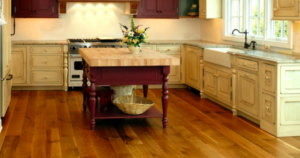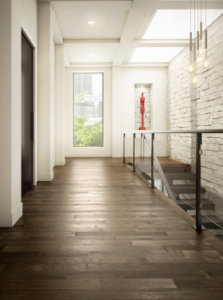The Most Popular Species of Hardwood Floors
Oak
Do you have children or pets? If so, consider oak flooring, graciously withstanding romps and stomps and resisting scratches. Similar to the flavor of fine wine, the color of oak becomes richer with time. The character of reclaimed oak testifies to this benefit. Another strength of oak is that it stains evenly, showcasing a wide variety of tints, from clean white to chocolate brown. The swirly grain patterns are classy, whether you like the uniformity of prime grade or the knotty “beauty marks” of character grade.
You can also choose from two species of oak, named for the color of their barks. Each wood has distinct advantages. White oak flooring is honey brown, while red has a pinkish hue. Red oak has a stronger grain than white, so it hides scratches and dents a bit better.
On the other hand, the tiger-striped grain of white oak is smoother and more consistent than red. On the Janka Hardness Scale, which rates durability, white oak supersedes red. But, whether you take a shine to red or white oak, both types are affordably priced.
Maple
If you prefer simplistic yet elegant decor, maple is an ideal option. The grain pattern is smooth and low-key, although occasional flecks and mineral streaks add visual interest. Light in color, the wood has a bright, clean, and expansive ambiance. Maple wood is super-strong, ranking higher than oak on the Janka Scale. Its range of hues includes blonde, light cream, and beige, often with a reddish tint. Since the wood isn’t very porous, staining is challenging, best done professionally. Many homeowners choose to let the natural beauty of maple prevail, protected with a clear sealant finish.
Over time, maple acquires a faint yellow tone. A coating of strong polyurethane prevents scratches from otherwise showing. Rubber soles can leave heel marks, remedied with an eraser and buffing. Since maple is so durable, denting is rare.
Like many hardwoods, maple reacts to fluctuating humidity, with temporary swelling and shrinking, and sometimes, warping or cracks. Wood shifting can be avoided by choosing engineered flooring. Despite its glamorous aura, maple is reasonably priced, approximating the cost of oak.
Ash
Possessing a light hue, this hardwood is airy like maple, but with a standout grain. When sourced from sapwood, ash can be creamy white or golden brown. Made of heartwood, the color is typically light tan. Ash is notable for its straight grain pattern and slightly springy feel. Similar to oak flooring, ash can handle heavy traffic. Additionally, being shock-resistant, ash is perfect in kitchens and family rooms, where objects are frequently dropped. Since water is highly visible on its surface, accidental slips and slides are less likely. Plus, the elastic nature of ash suits areas subject to radiant heat and high humidity.
Like oak, ash absorbs stains well. However, its natural color is so pleasing, you may wish to preserve it, with a protective, clear finish.
Pine
Do you favor a rustic look? If so, you’ll love pine flooring, with its abundant knots, pinholes, and prominent grain. Occupying the low end of the Janka Scale, pine is technically a “softwood.” Though this term gives a cushy image, the wood isn’t actually soft, just impressionable, reflecting household activity over time. Still, many homeowners find that a few dents and dings make their rooms more welcoming. Plus, the patina that emerges with use gives the flooring a homey glow. While yielding to impact, pine flooring is durable and long-lasting, especially when finished with polyurethane sealant. You can also opt for heart pine, stronger than southern yellow pine. Or, use pine flooring in areas where traffic is moderate, such as a home office.
With a vast color palette, pine is available in white blonde, honey gold, deep brown, and reddish mahogany. The wood stains beautifully and resists humidity. Another advantage of pine is that it’s highly economical.
Solid Footing
At Classic Floor Designs, our stateside clients include the White House, US Mint Building, and Four Seasons Hotel. Our work has earned awards from the National Flooring Association and the Washington Building Congress. Overseas, we’ve installed flooring for ambassador homes in Belgium, Germany, and France.Among choice hardwood flooring options, oak, maple, ash, and pine are homeowner top picks. However, these are just a few of the high-performance woods from our broad selection. To launch the fulfillment of YOUR vision, call us for a free consultation at (202) 872-9860.
With 40+ years in custom flooring, you can stand on our solid reputation – for years to come.




